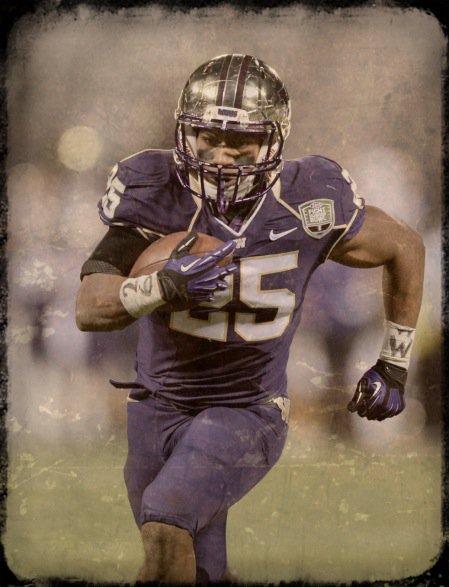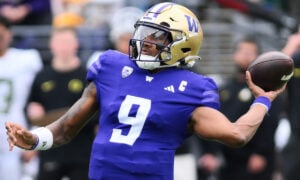Bishop Sankey: It’s OK to be Safe
 Many draftniks, including myself, feel that although Bishop Sankey isn’t the flashiest back in the draft, he might be the most dependable, safe runner that this year’s class has to offer. Sankey is a solid, muscular 5’ 9”, 209 lbs., who ran a 4.49 40 at the Combine. He was a Washington Husky team captain and managed to accumulate 653 combined touches while starting his sophomore and junior years. His considerable workload is a little concerning, but on the bright side, this talented back found a way to score a touchdown in 23 out of 26 college games started.
Many draftniks, including myself, feel that although Bishop Sankey isn’t the flashiest back in the draft, he might be the most dependable, safe runner that this year’s class has to offer. Sankey is a solid, muscular 5’ 9”, 209 lbs., who ran a 4.49 40 at the Combine. He was a Washington Husky team captain and managed to accumulate 653 combined touches while starting his sophomore and junior years. His considerable workload is a little concerning, but on the bright side, this talented back found a way to score a touchdown in 23 out of 26 college games started.
To get a good idea of what skill set Sankey brings to the NFL, I re-watched eight of his 2013 games against Oregon State, UCLA, California, Oregon, Stanford, Illinois, Boise State and BYU. I find it is important to see how a player performs against various levels of competition to determine his strengths and weaknesses.
Sankey seems to prefer and do the majority of his damage running between the tackles, most particularly in the zero (center’s lane) and two gaps (the guards’ lanes). He is a good inside runner who gets low and squares his shoulders, bracing to take and receive punishment. He seems to enjoy the contact, especially delivering the wood. Don’t confuse him with a speed back like Lache Seastrunk as Sankey is a more deliberate back who has much less wiggle. He reminded me and surprisingly, NFLN’s Daniel Jeremiah, of a less talented Doug Martin. I say “surprisingly” because I always watch the games before I read what someone else may have written about a player as Mr. Jeremiah and I don’t always agree. As a habit, I go to nfl.com to verify the rookie’s height, weight, and 40 yard dash time for accuracy after I write my thoughts.
I will do something different and let you know Sankey’s weaknesses up front and save the praise for him a little later. The young runner is somewhat of a liability in the passing game. He doesn’t always set his feet to meet the defender head on, takes the occasional bad angle and tries to cut block bigger players – this is a huge issue as a more athletic defensive end or linebacker will hurdle right over him with that kind of effort, all the while picking up steam on the way to smash the quarterback.
Sankey is not a natural hands catcher as he uses his body to secure the ball on at least half his receptions, even though he was used as a receiver more than most college offenses ask of their backs. He focuses on the defense when he should be looking the ball into his hands. He seems to do best with short dump off passes that leave him in space. His hands may limit him initially to a two down role, unless he can significantly improve his pass blocking and pluck the ball instead of trying to cradle it into his arms.
When Sankey gets faced with inside penetration, he can get strung out wide and lose yardage quickly. He does much better when a counter is the play call to get the defense off balance for him. Sankey also doesn’t have much of a second gear as the back can explode for about 15 to 20 yards before he is back to his usual stride. He also seems a little tight in the hips, which makes it harder for him to change directions quickly. I have my doubts we will see many 40+ yard runs from him in his NFL career.
Now let’s focus on his considerable strengths.
Sankey does a good job bouncing off first contact and does not go down with any sort of arm tackle. Defenders who make the mistake of hitting him high or low are usually looking up at him running away. He can catch himself after being knocked back and find a crease to exploit. He has a good jump cut combined with quick feet that he uses to avoid tacklers. It’s his great center of gravity that makes him dangerous as he can keep on running after taking massive hits. On a few occasions, he will pull out a spin move or two in space.
Sankey is a powerfully built back. He has strong legs, gets good leverage and generates a lot of torque with his hips. Eight times out of ten, he finds a way to fall forward in order to gain additional yardage.
It’s his nose for the end zone that makes him a huge plus for dynasty owners. I haven’t seen a back more determined to score a touchdown in this draft class. He constantly keeps his feet chopping trying to break tackles, while trying to swat defenders away. Sankey uses a strong stiff-arm that is quite effective keeping tacklers off his body. It’s the additional effort to keep the play going that sets him apart from everyone else.
He is a patient runner especially when he is following a pulling lineman or on a counter. It’s his outstanding vision that helps him read the rushing lanes quickly. It’s not uncommon for him to go from blocker to blocker down the field, using them like a paintballer would use bales of hay. Sankey is a high effort player as he is a willing blocker when he is not the ball carrier, knocking defenders off their feet. I was much more impressed with his run blocking than I ever was with his pass blocking. Washington used him in the wildcat on a few occasions as it got him out in space in a hurry. Although he had a few fumbling issues, Sankey is doing a better job at putting both arms around the ball when he is being tackled.
Once you compare Sankey to his fellow rookie backs, it’s his on-field production and character that makes him the safest running back choice in his class. Sure, Jeremy Hill and Carlos Hyde are bigger and more bruising type backs, but they have off-field baggage. Lache Seastrunk and Charles Sims are more elusive and quick, but call me old-fashioned as I like dependable. Year one, I expect a season much like Zac Stacy’s as Sankey might not start the season as a starter, but should finish it that way, depending on where he’s drafted.
For further questions or comments, please contact me on twitter @AndrewMiley

































































